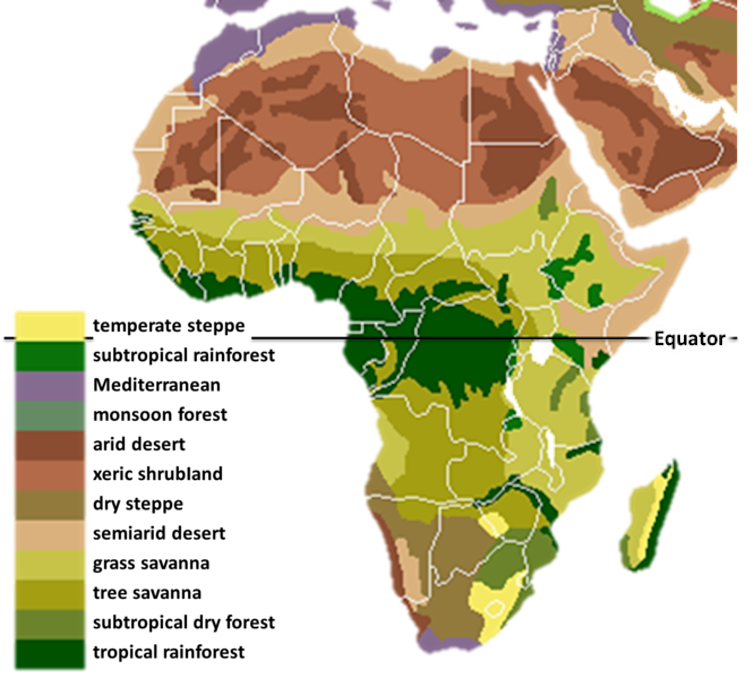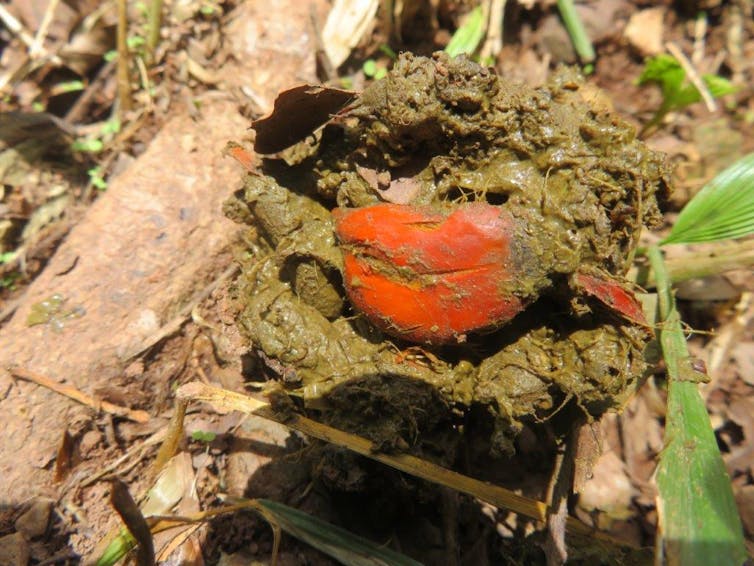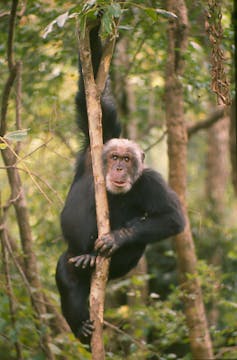Most people probably think that the rainforest of central and west Africa, the second largest in the world, has been around for millions of years. However recent research suggests that it is mostly just 2,000 or so years old. The forest reached roughly its modern state following five centuries of regeneration after it was massively fragmented when the dry season suddenly became longer some 2,500 years ago.
This process was not linked to humans. The forest recovery was instead made possible by seed dispersers including chimpanzees, which helped spread the slower-growing rainforest tree species. However, dispersers such as chimpanzees are now threatened by deforestation and hunting, often for bushmeat. When combined with climate change, the resilience of the rainforests seems less guaranteed for the future.
I began thinking about natural processes in African forests back in 1993, when I was with my wife-to-be trying to follow wild chimpanzees next to Jane Goodall’s famous group at Gombe, in Tanzania. We were inspired by one of the directors of research at Gombe, Anthony Collins, who suggested that the chimpanzees might be influencing the composition of the forest for their own nutritional needs, by what fruits they pooed out and where. A kind of “proto gardening”.
And then unexpectedly I had to leave the chimpanzees after I succeeded in getting a small grant to study past vegetation change using fossilised pollen, but in the Andes.
A few years later, I found myself giving lectures at Cambridge on human impacts over the past 10,000 years, and suddenly “returning” not only to the tropical rainforests of Africa, but their history. At the time, scientists thought humans were largely responsible for the collapse of the forests from 3,000 years ago.
The first few scientific papers I read used the abundance of pollen from the oil palm tree, preserved in the dated layers of lake muds, as an indicator of human activity. The oil palm is the same species often planted on a massive industrial scale in the tropics today, and since it’s always been an important source of nutrition for people in the region, scientists had assumed it indicated the presence of humans.
Shortly after, I began working in a pollen laboratory in Montpellier in southern France which had a long-term focus on African forest history. There, my simplified view of fossilised oil palm pollen equalling the presence of humans was totally overturned.
Rainforest history records were being amassed that indicated the near-decimation of rainforests some 2,500 years ago in the Congo Basin and across a huge expanse stretching from modern-day Senegal to Rwanda. As there was only very limited archaeological evidence of thinly dispersed human populations, humans could not have been responsible for the almost synchronous destruction on such a huge scale.
Africa hosts the world’s second largest rainforest

So what did cause these rainforests to collapse? It turns out the answer was not humans, but climate change.
In a paper recently published in the journal Global Planetary Change, my colleagues Pierre Giresse, Jean Maley and I use the many vegetation records available across central and west Africa to show that approximately 2,500 years ago, the length of the dry season increased. Rainforests became highly fragmented, and savanna vegetation – grasses, scattered shrubs and trees – moved in.
In the centuries that followed, the forests regenerated spontaneously, including with species such as the oil palm. The oil palm demands a lot of light and so thrives in open areas or in the gaps created in forests when the canopy opens up rather than in the dense centre. Thus it often acts as a “pioneer species” allowing the forest to regrow.
But the oil palm’s large seeds are too heavy to be blown in the wind. They therefore need to be dispersed in the poo of animals such as chimpanzees which are able to swallow the large seeds and for whom the bright orange flesh can be an important part of the diet. And this is how chimps and other seed-dispersers played a crucial role in regenerating Africa’s rainforests.

Seed dispersers under threat
When we began this research, we could not see how relevant it would become during the current pandemic. Now climate change, deforestation and hunting are all heavily impacting those same forests. The bushmeat market is contributing to removing keystone species such as chimpanzees. Without animals to move seeds around – especially the largest and heaviest seeds – the natural composition and regeneration of forests is threatened.
At the turn of the 20th century there were around 1 million chimpanzees, but today only an estimated 172,000-300,000 remain in the wild. Chimps and other seed-dispersing species provide a valuable service and must be better protected in order to protect the forests themselves, and prevent further unforeseen impacts.

For example, the transmission of diseases to humans has also been linked to the bushmeat trade. And transmission is not necessarily one way. In June 1996, three years after my wife and I left the chimps at Mitumba in Gombe National Park, possibly up to half the group died within a few days of a respiratory disease outbreak that was likely transmitted to them by humans.
Perhaps there is a lot more resilience in these tropical forest ecosystems than we can predict. But without chimpanzees and other animals as dispersers, the emptier forests that may eventually grow back would be a sad replacement. Maybe we need to consider the true value of chimp poo, and those that produce it.
Alex Chepstow-Lusty does not work for, consult, own shares in or receive funding from any company or organisation that would benefit from this article, and has disclosed no relevant affiliations beyond their academic appointment.
This article was originally published on The Conversation. Read the original article.







